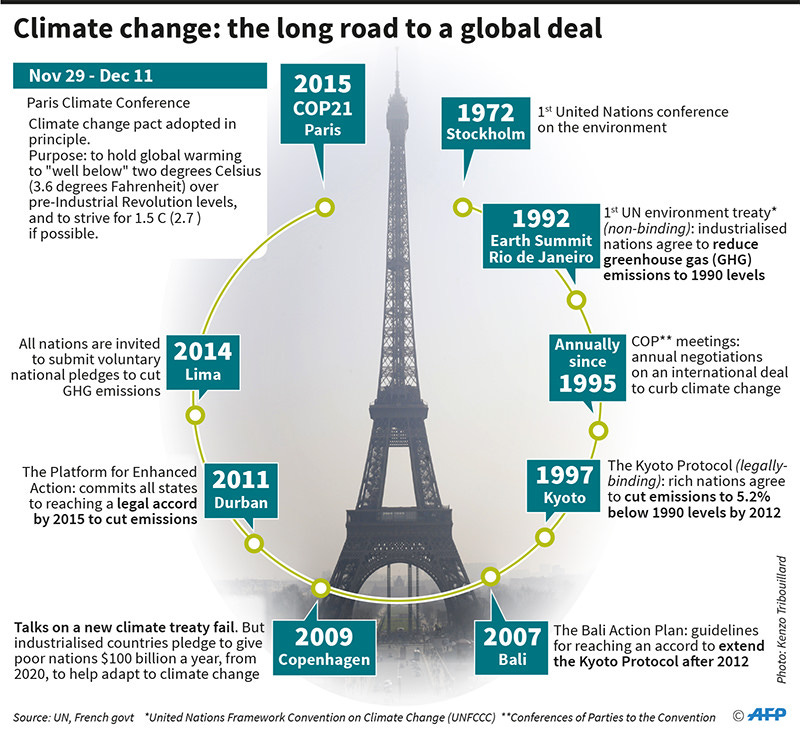#19: What Do I Need To Really Know About COP26?
195 countries will descend on Glasgow shortly to attend the world's largest climate forum. We'll cover the small set of points the vast majority of the population need to actually understand.
PRESSED FOR TIME?
It is right to say COP26, and the meeting of the world’s governments in Glasgow next week represents the last good chance to avert the most catastrophic effects of climate change. But it’s helpful for you to understand the bones of how the conference will actually work: specifically what is the difference between a hollow announcement and a big result, and how companies and markets are already responding.
HOW DID WE GET TO COP26?
In 1992, a meeting took place in Rio De Janeiro to establish the COP process, or the Conference of the Parties. The parties are the parties to the United Nations Framework on Climate Change (UNFCC) treaty signed in Rio. The IPCC reports we’ve covered on Climate and Money in the past feed into this process. Since that time the world has been unanimously participating in a series of meetings and negotiations known as the UN Convention on Climate Change, all with the intended goal of keeping global warming to 1.5C above pre-industrial levels.
It’s important to stress this: some foreign leaders might’ve not attended for domestic reasons or for politics (like President Xi and President Putin this year), but every country has sent a delegation. Since the science became clear, the world has been focused on this problem, even if it wasn’t reported a great deal in our media cycles.
COP1 took place in Berlin in 1995, and laid out the idea of differentiated responsibilities. What does this mean? The burden of the transition should disproportionately fall on rich countries, who’d set up this large global industrial energy complex and benefited from cheap fossil fuels in their growth trajectory. The Chair of that conference? The German Environment Minister, a mid-career female PhD by the name of.. Angela Merkel.
I played a very, very small part in my 20s with the Australian Government in the lead-up to the COP15 meetings in Copenhagen, in December 2009. Now seen as an historic failure, US president Barack Obama said: "While the reality of climate change is not in doubt … I think our ability to take collective action is." The Paris Agreement in 2015 was a slight act of redemption for Copenhagen (though years and momentum were lost), and the treaty agreed there gives rise to something you hear now and then in the media: NDCs, or national determined contributions. These are the targets each country sets for itself with regards to emissions reductions by 2030 and 2050 (NB: this is why you always hear those dates in discussion). No one can force a country to decarbonise, it’s all voluntary commitments. Hence Obama’s valid doubt on collective action against a common threat.
Current climate pledges aren’t anywhere near close enough to achieving the 1.5C target. Unanimity on the problems and unanimity on the goals are one thing. Agreeing to the hard choices is another. In the best case scenario, the world is on pace to record a 2.7C warming. As you’ve probably heard many times by now, this 1.2C difference is NOT a temperature difference on a warm day, it’s an exponential unbuckling of the fragile ecosystems around the world that enable plants (and food) to grow, water to convert into rain, oceans to allow certain fish life, and many many other byproducts we can’t be assured of if that level of warming is achieved. Everything we’ve known as humans has operated on a very delicate balance, and fossil fuel emissions have tinkered with that formula and changed our climate globally in a permanent way.
The point of next week’s meeting is to try and get back on track.
SO WHAT HAPPENS AT THESE CONFERENCES?
How should we picture a COP? They’re staggering events. Over 30,000 credentialled, official delegates and hoards of NGOs gather to meet. The first week is a technical week with expert negotiations, and the second week is where Ministers and heads of governments convene to thrash out simple, short communiques and summaries of each commitment.
It’s the epitome of multilateralism. Uganda has theoretically the same voice as the United States. How is any agreement struck? It’s basically peer pressure. There is no centralised body that can punish or threaten those who don’t cooperate (there’s a little bit of enforcement from prior treaties, but that’s a little too technical for this forum). The hope is that the COP process is driven by shifting global opinion, and governments through domestic political pressure revisit the COP process every few years with greater commitments.
WHAT ARE THE ECONOMICS OF ALL OF THIS?
Let’s focus on the money side of COP26.
It boils down to a simple question: can the economies of the world shift to a reliance on non-fossil fuel energy sources, without sacrificing growth and living standards?
Economics and market watchers focus on two mechanisms for how this could occur. One is carbon pricing. The idea would be to establish a global minimum carbon price. That requires a lot of design and modelling, as well as offsets to poorer countries that would likely be exploited and undermine confidence. That doesn’t mean we shouldn’t be striving for it, it’s just the reality of such a big reform to global trade.
The second (and in my view, somewhat positive) path is to break down the problem into five buckets, and tackle each with dedicated plans. The five buckets are broadly defined as:
electricity generation
transportation
industry
agriculture
housing
At a first approximation, they’re roughly the same size. Depending on the country you live in, each of these emission areas is roughly 15-30% of total emissions.
Electricity generation is fairly simple: go for renewables, store more energy, make some big strides on hydrogen, and depending on the country, incorporate nuclear energy as a backup option with high reliability for baseload needs. Transport likewise has a roadmap well understood in the industry. Vehicles can be electrified, we’ve known that for a hundred years. Shipping companies are making big strides, and though technical challenges exist with air travel, it’s a relatively small portion of global transport in energy terms compared to cars and ships.
Industry could be depressing if you’re a glass half empty kind of person, because concrete, steel and petrochemicals are so energy-intensive and require temperatures (i.e. aluminium at 1200 degrees Celsius) for which solar and wind energy can seldom be relied upon. But: it is a concentrated sector, with large corporations, incredible incentives and R&D value chains that have been proven to deliver in many other recent breakthroughs. If you think about the pot of revenue gold at the end of the rainbow for the firms that perfected non-stick frying pans, microwave ovens, stain-free kitchen tops or LED lights in the last fifty years, then we’ve no reason to think the profit motive won’t be as powerful for the first designer of room-temperature cement production.
Agriculture is pretty simple, just something we don’t want to hear. We need to massively reduce the amount of meat we eat, and then as a secondary solution, reduce dairy. Housing is not complicated, it’s just fragmented. Millions and millions of buildings with different owners and local codes needs insulation and old systems replaced, along with a host of other small iterations.
Two stats that regularly shock people in my world of real estate and design: construction equivalent to a whole new New York City is built around the world every 28 days, and 80% of the built environment assets in the world are already built. How can both be possible? They just are, remarkably. In the very near-future, it’s going to be problematic to own old buildings that haven’t been retrofitted to new standards. Again, internal industry momentum is strong, not least because the cost and availability of debt is forcing developers and investors to go green.
SHOULD WE BE GLASS HALF FULL OR EMPTY?
So should you click on the news over the next week and feel optimistic or pessimistic? That is for you to decide, but I’ll editorialise for a rare occasion and give you my answer.
I am optimistic. We live in cynical times, and there is plenty to be cynical and despondent about, whatever your politics.
We shouldn’t see the challenge of decarbonisation as a cost. It’s going to make the world a lot better, and more liveable.
The scale of the price tag is big, but if you put on a macroeconomics hat, it’s actually well below wartime levels. The cost to do all this is in the low-single digit trillions, which needs to be seen in the context of a global GDP of $80 trillion annually. Does it start to feel a little more manageable when put like that?
Moreover most of this is growth, lifestyle and economically enhancing. Our cities will have better air quality as we get rid of combustion engines. Air quality might feel a ‘nice to have’ in Boston, Brisbane or Berlin, but it’s going save thousands of lives in Bombay or Baghdad. Our food will be better when grown differently. Our diets and life expectancy will improve. Our buildings will have a more consistent thermal feel, and need to be invested in less frequently. Our oceans will be inundated with less plastic.
COP26 is about politics. It’s about managing interest groups, and constraining those who are resistant. It’s about selling a hopeful message to the world’s media at the end. Whether the message is positive or negative coming out of Glasgow, remember the money is already moving. The biggest winners are tackling huge top line growth challenges in these five buckets, and nearly all of the falling stocks in the Dow Jones Industrial Average are resisting change.
We’re on the right path, we just need to move faster. Enjoy your two weeks of Glasgow coverage with at least a little peace of mind.
Optimistically,
Owen C. Woolcock
3 Questions I Am Asking Myself This Week
1. Are you a Biden legislation watcher without the time to dive deep? This Google Doc has been kindly put together to give a simple list of all the measures related to climate.
2. In an incredible graphic this week, I learned the population of EIGHT U.S. states would fit inside New York City:
Consider something like Local Law 97, which mandates large commercial buildings in NYC must meet carbon emissions limits by 2024 or pay fines, and it’s a measure equivalent to a new law in eight entire states. Cause for hope when dense urban markets act first with new types of decarbonisation reform.
3. Who really benefits from delayed climate action, and how much of those profits are eaten away in reputational damage and delays to transferring capital into more lucrative industries?
If You Read Or Listen To One Thing This Week
An excellent NYT story on the climate impacts in small town bankruptcies.







